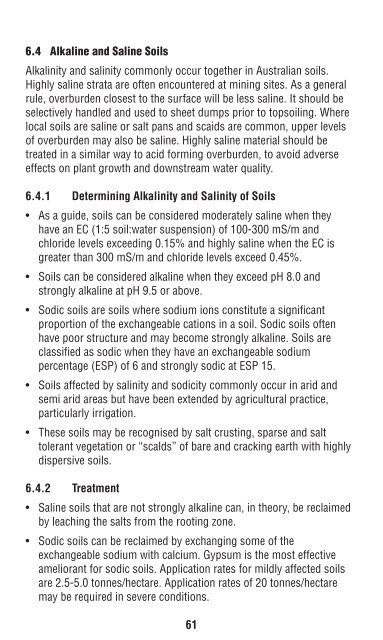Mine Rehabilitation Handbook - Mining and Blasting
Mine Rehabilitation Handbook - Mining and Blasting
Mine Rehabilitation Handbook - Mining and Blasting
Create successful ePaper yourself
Turn your PDF publications into a flip-book with our unique Google optimized e-Paper software.
6.4 Alkaline <strong>and</strong> Saline Soils<br />
Alkalinity <strong>and</strong> salinity commonly occur together in Australian soils.<br />
Highly saline strata are often encountered at mining sites. As a general<br />
rule, overburden closest to the surface will be less saline. It should be<br />
selectively h<strong>and</strong>led <strong>and</strong> used to sheet dumps prior to topsoiling. Where<br />
local soils are saline or salt pans <strong>and</strong> scaids are common, upper levels<br />
of overburden may also be saline. Highly saline material should be<br />
treated in a similar way to acid forming overburden, to avoid adverse<br />
effects on plant growth <strong>and</strong> downstream water quality.<br />
6.4.1 Determining Alkalinity <strong>and</strong> Salinity of Soils<br />
• As a guide, soils can be considered moderately saline when they<br />
have an EC (1:5 soil:water suspension) of 100-300 mS/m <strong>and</strong><br />
chloride levels exceeding 0.15% <strong>and</strong> highly saline when the EC is<br />
greater than 300 mS/m <strong>and</strong> chloride levels exceed 0.45%.<br />
• Soils can be considered alkaline when they exceed pH 8.0 <strong>and</strong><br />
strongly alkaline at pH 9.5 or above.<br />
• Sodic soils are soils where sodium ions constitute a significant<br />
proportion of the exchangeable cations in a soil. Sodic soils often<br />
have poor structure <strong>and</strong> may become strongly alkaline. Soils are<br />
classified as sodic when they have an exchangeable sodium<br />
percentage (ESP) of 6 <strong>and</strong> strongly sodic at ESP 15.<br />
• Soils affected by salinity <strong>and</strong> sodicity commonly occur in arid <strong>and</strong><br />
semi arid areas but have been extended by agricultural practice,<br />
particularly irrigation.<br />
• These soils may be recognised by salt crusting, sparse <strong>and</strong> salt<br />
tolerant vegetation or “scalds” of bare <strong>and</strong> cracking earth with highly<br />
dispersive soils.<br />
6.4.2 Treatment<br />
• Saline soils that are not strongly alkaline can, in theory, be reclaimed<br />
by leaching the salts from the rooting zone.<br />
• Sodic soils can be reclaimed by exchanging some of the<br />
exchangeable sodium with calcium. Gypsum is the most effective<br />
ameliorant for sodic soils. Application rates for mildly affected soils<br />
are 2.5-5.0 tonnes/hectare. Application rates of 20 tonnes/hectare<br />
may be required in severe conditions.<br />
61<br />
• Prolonged irrigation will leach out sodium <strong>and</strong> other deleterious salts<br />
from saline <strong>and</strong> sodic soils but is only practical when the soil remains<br />
permeable, the water table is well below the root zone <strong>and</strong> an<br />
adequate supply of suitable water is available.<br />
• Forming water impoundments 300-400mm high to induce infiltration<br />
<strong>and</strong> leaching of salts is widely used in agriculture. Several seasons<br />
are required to achieve sufficient leaching in arid areas.<br />
• Ridge-ploughing to form ridges 200-300mm high spaced at 1-2<br />
metres apart enables a more rapidly leached root zone to be formed<br />
for direct seeding <strong>and</strong> planting.<br />
6.5 Heavy Metals <strong>and</strong> Toxic <strong>Mine</strong>s Waste<br />
• Heavy metals occurring naturally on the site may be mobilised <strong>and</strong><br />
cause a potential health or environmental problem in overburden,<br />
soils <strong>and</strong> water. Acid conditions <strong>and</strong> acid drainage indicate a possible<br />
heavy metals problem.<br />
• Arsenic, cadmium, mercury, lead, nickel, manganese <strong>and</strong><br />
molybdenum are cations that are potentially harmful to human life<br />
because they bio-accumulate <strong>and</strong>/or require relatively small dosage<br />
to affect health.<br />
• Elevated levels of radioactivity may be associated with some mine<br />
wastes. Identification <strong>and</strong> appropriate disposal of these wastes is<br />
essential to avoid impact through: - direct exposure, offsite<br />
contamination, or animals browsing on vegetation that has<br />
accumulated radioactive elements.<br />
• Copper is the principal concern for aquatic systems; however, other<br />
heavy metals may accumulate in sediments.<br />
• Aluminum, manganese, copper, zinc <strong>and</strong> lead may become available<br />
in acid soils <strong>and</strong> be toxic to plant growth.<br />
• Sub-grade ore, waste rock etc, which has the potential to generate<br />
acidity <strong>and</strong> mobilise metals, should be selectively placed within<br />
waste dumps (refer section 6.3).<br />
• Neutralise the upper 200mm of waste material with lime or similar<br />
material (refer 6.3) to provide a buffer against possible mobilisation<br />
by acid drainage.<br />
62
















